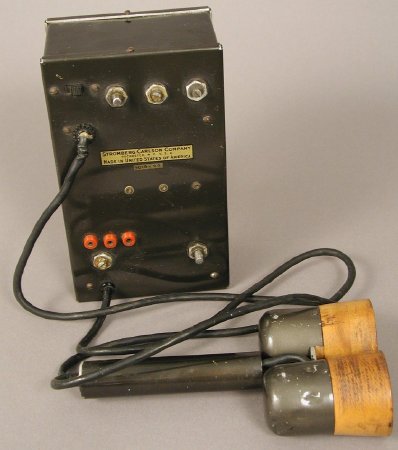Object ID:
2007.33.19
Title:
Stromberg-Carlson Pulsed Frequency Modulation Model ETA
Creator:
Haskins Laboratories
Description:
Dark olive green enameled aluminum case with brackets on sides for missing shoulder strap; two black insulated wires lead out of front of case from top and bottom to aluminum handled pair of "manetostriction transducers", a device that resembles a flashlight with two heads, conical wooden pieces on their ends; front of case has a sliding on-off toggle on top left with three rotary knobs to right; yellow label in middle, "STROMBERG-CARLSON COMPANY/ROCHESTER, N.Y, U.S.A./MADE IN UNITED STATES OF AMERICA/9019-22"; two more rotary knobs on bottom with three redjacks above the lower left knob; interior of case has upper and lower banks of tubes; upper bank labeled "Sawtooth Osc." and "Supersonic Osc."
Dimensions:
H-8.5 W-5 D-4 inches
Date:
1947
Made by:
Haskins Laboratories, Stromberg-Carlson
Place of Origin:
New York, NY
Provenance:
At the end of WWII, The U.S. Office of Scientific Research and Development asked Haskins Laboratories, a private research firm associated with Harvard and MIT, to test and develop technologies for assisting blinded soldiers from the war. Haskins oversaw work by several contractors. This project was one investigated by the electronics firm Stromberg-Carlson, which developed four different experimental devices which transmitted sound and used the sound's reflection to detect obstacles ahead, based on the basic principles of radar/sonar. Frank Slaymaker, Benjamin Olney, And Willard Meeker were the principal investigators. This model is one of the two handheld devices, the other two were not portable. None of the four advanced beyond the experimental stage and had been discontinued by 1947.
Credit Line:
Gift of Association for Education and Rehabilitation of the Blind and Visually Impaired
